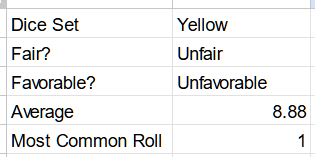64
you are viewing a single comment's thread
view the rest of the comments
view the rest of the comments
this post was submitted on 25 Mar 2024
64 points (100.0% liked)
Tabletop Gaming
1333 readers
1 users here now
All things relating to and about tabletop gaming and board gaming generally!
See also Tabletop Gaming's sister community Gaming.
This community's icon was made by Aaron Schneider, under the CC-BY-NC-SA 4.0 license.
founded 1 year ago
MODERATORS

I know some of these words
Mind giving an ELI5 version?
Here's the data for 100 rolls with the yellow die if it helps.
I copied it right out of the spreadsheet so I'm pretty sure it's formatting is borked.
4 4 15 5 11 15 9 20 7 19 5 12 17 6 18 5 3 2 19 14 5 8 9 1 7 7 2 7 7 2 19 13 11 7 5 3 5 9 15 14 5 3 12 1 9 1 20 19 13 1 1 3 6 2 3 8 13 15 4 4 1 16 2 5 1 12 12 1 5 3 14 11 13 6 8 7 11 19 6 13 20 3 12 15 4 4 4 10 20 1 7 1 16 9 14 10 16 12 20 15
Basically he is giving you info on how to interpret the result you got. A t-test (Student's t-test) gives a "p-value" which sometimes comes up in some articles regarding a statistical result. It is a way of assessing whether the result you got is different enough from the expected value (a fair die) taking into account that you can't throw the dice an infinite amount of times. Generally a p-value less than 0.05 is considered statistically significant* and you can trust your result.
You can do the calculation here too if you want to get some values about it and more info.
*) Sort of means that there is only a 5% probability that your result is due to randomness.
This assumed you only tested one die.
If OP tested a thousand dice, and this is the one that came out on the bottom, then it's incredibly likely it's just random because of how many dice were tested.
MULTIPLE COMPARISON CHANGES THE RULES OF STATISTICAL HYPOTHESIS TESTING, and the OP is giving us a single result from multiple comparisons which are censored.
Probably an innocent mistake, but not valid.
With one die we can calculate the probability of getting that result and compare it to a distribution of fair dice, that gives us a probability of 0.24% that the average of 100 rolls of a 20 sided fair die is 8.88 or lower.
Knowing op rolled 17 dice (17 sets of 100) we can calculate the probability of that even happening with fair dice to be around 4% meaning very likely that die is unfair.
At least this is how i think this goes
I gave the tool a test using the data on the rolls I mentioned in the previous comment (under the spoiler tag) and it said "very statistically significant"
Definitely worth looking more into it IMO
Time to gather more data!